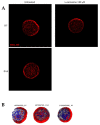Oxidative Stress Modulation by Carnosine in Scaffold Free Human Dermis Spheroids Model: A Proteomic Study
- PMID: 35163388
- PMCID: PMC8836079
- DOI: 10.3390/ijms23031468
Oxidative Stress Modulation by Carnosine in Scaffold Free Human Dermis Spheroids Model: A Proteomic Study
Abstract
Carnosine is an endogenous β-alanyl-L-histidine dipeptide endowed with antioxidant and carbonyl scavenger properties, which is able to significantly prevent the visible signs of aging and photoaging. To investigate the mechanism of action of carnosine on human skin proteome, a 3D scaffold-free spheroid model of primary dermal fibroblasts from a 50-year-old donor was adopted in combination with quantitative proteomics for the first time. The label free proteomics approach based on high-resolution mass spectrometry, integrated with network analyses, provided a highly sensitive and selective method to describe the human dermis spheroid model during long-term culture and upon carnosine treatment. Overall, 2171 quantified proteins allowed the in-depth characterization of the 3D dermis phenotype during growth and differentiation, at 14 versus 7 days of culture. A total of 485 proteins were differentially regulated by carnosine at 7 days, an intermediate time of culture. Of the several modulated pathways, most are involved in mitochondrial functionality, such as oxidative phosphorylation, TCA cycle, extracellular matrix reorganization and apoptosis. In long-term culture, functional modules related to oxidative stress were upregulated, inducing the aging process of dermis spheroids, while carnosine treatment prevented this by the downregulation of the same functional modules. The application of quantitative proteomics, coupled to advanced and relevant in vitro scaffold free spheroids, represents a new concrete application for personalized therapies and a novel care approach.
Keywords: carnosine; dermis spheroids; high-resolution mass spectrometry; network analyses; oxidative stress.
Conflict of interest statement
The authors declare no conflict of interest.
Figures





References
-
- Larroque-Cardoso P., Camare C., Nadal-Wollbold F., Grazide M.H., Pucelle M., Garoby-Salom S., Bogdanowicz P., Josse G., Schmitt A.M., Uchida K., et al. Elastin modification by 4-hydroxynonenal in hairless mice exposed to uv-a. Role in photoaging and actinic elastosis. J. Investig. Dermatol. 2015;135:1873–1881. doi: 10.1038/jid.2015.84. - DOI - PubMed
-
- Aldini G., de Courten B., Regazzoni L., Gilardoni E., Ferrario G., Baron G., Altomare A., D’Amato A., Vistoli G., Carini M. Understanding the antioxidant and carbonyl sequestering activity of carnosine: Direct and indirect mechanisms. Free Radic. Res. 2021;55:321–330. doi: 10.1080/10715762.2020.1856830. - DOI - PubMed
-
- Dissette V., Bignozzi C.A., Valacchi G., Pecorelli A., Manfredini S., Vertuani S. Evaluation of the transepidermal penetration of a carnosine complex in gel formulation by 3d skin models. Cosmetics. 2018;5:67. doi: 10.3390/cosmetics5040067. - DOI
-
- Aldini G., Carini M., Yeum K.J., Vistoli G. Novel molecular approaches for improving enzymatic and nonenzymatic detoxification of 4-hydroxynonenal: Toward the discovery of a novel class of bioactive compounds. Free Radic. Biol. Med. 2014;69:145–156. doi: 10.1016/j.freeradbiomed.2014.01.017. - DOI - PubMed
MeSH terms
Substances
LinkOut - more resources
Full Text Sources
Molecular Biology Databases

